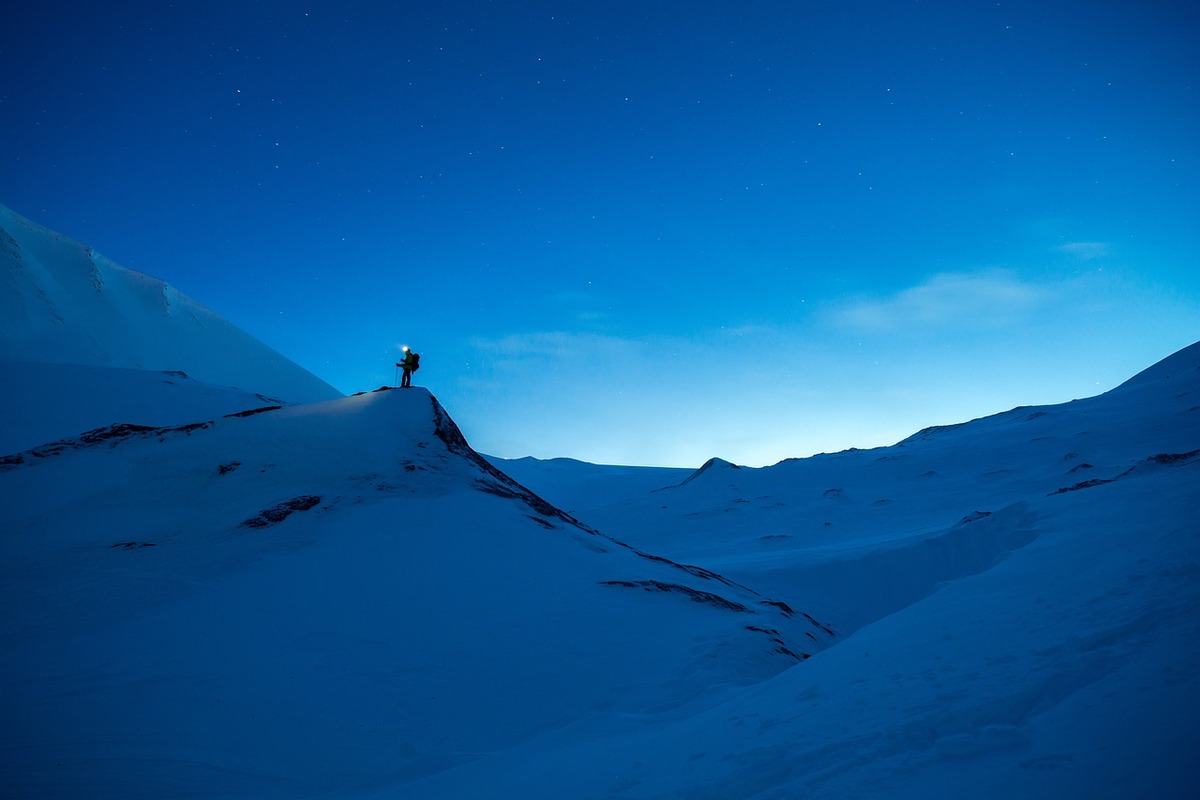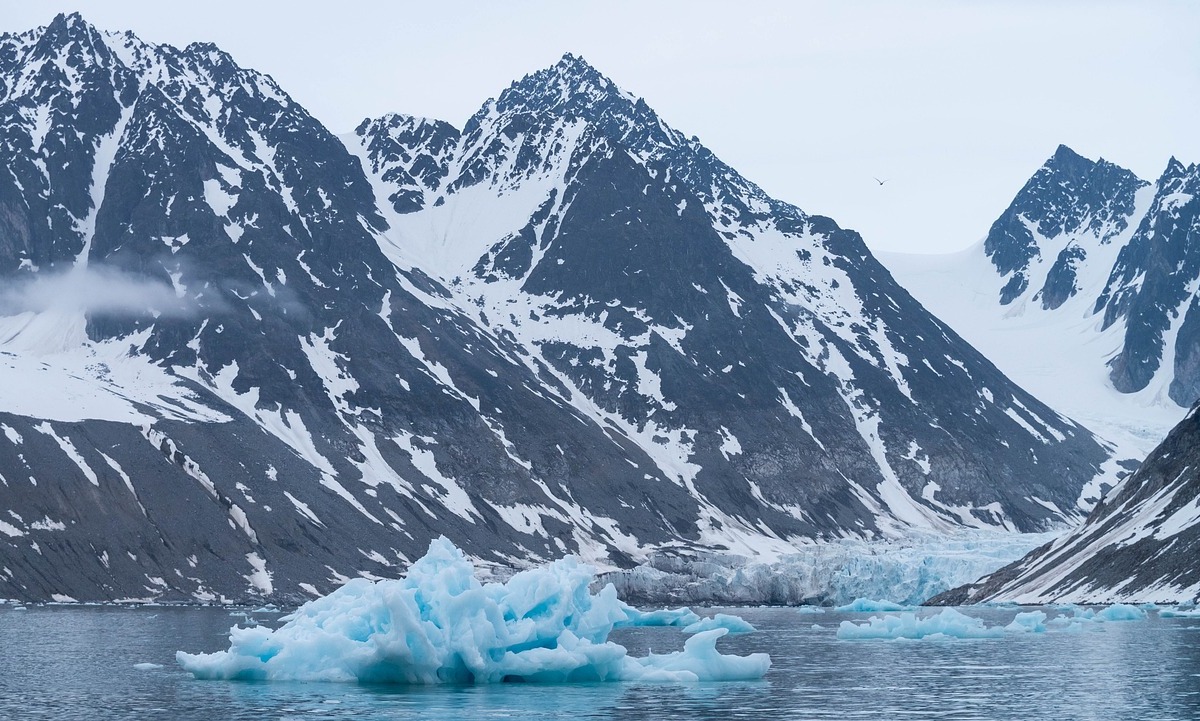Trips to Svalbard overview – Explore the Svalbard Islands with Exped Tribe!
Svalbard is a fascinating archipelago in the Arctic Ocean that is an ideal destination for explorers and adventurers who love breathtaking landscapes. Although the region is known for its icy environment and impressive wildlife, it also offers the opportunity for challenging activities such as mountaineering, skiing and sailing.
Newtontoppen is the highest mountain on Svalbard and attracts mountaineers from all over the world. With an altitude of 1713 m, Newtontoppen offers a demanding challenge for experienced expedition enthusiasts. The ascent requires technical skills and experience in dealing with alpine conditions. But the effort is worth it, because from the summit you can enjoy spectacular views of the surrounding glaciers and the Arctic landscape. You will also have to pull your own pulka, as provisions and equipment have to be carried.
If you are an avid skier, the Svalbard Islands are also a paradise for ski touring. The region offers untouched snow slopes and wide open spaces that provide ideal conditions for ski touring. You can explore the majestic landscape while gliding through untouched snowfields and enjoying the silence of the Arctic.
Another exciting adventure on Svalbard is sailing. The archipelago is criss-crossed by fjords and coastlines and offers numerous opportunities to explore the waters in a sailing boat. You can sail along the coast and discover impressive glaciers, wildlife sightings and secluded bays. The incredible potential of the island unfolds as soon as you combine sailing with skiing: don’t miss out on our Sail and Ski trip on Svalbard!
Apart from the outdoor activities, Svalbard also offers a rich wildlife and a fascinating history. You can observe reindeer, Arctic foxes, seals and polar bears in their natural environment. The archipelago has historically been an important starting point for polar explorers and therefore offers a rich history of discovery and exploration. What are you waiting for? Book your next trip to Svalbard now and experience a unique adventure that combines mountaineering on Newtontoppen, skiing and sailing. Immerse yourself in the breathtaking Arctic landscape and discover the wonders of this fascinating archipelago.
Ski and Sail
Ski and Sail Svalbard 7 days
During the sailing sections you will explore the coastline and fjords of Spitsbergen, surrounded by majestic glaciers and impressive wildlife. As soon as we see a deep snowy line that appeals to us, it’s time to ski! We will be taken by sailboat to the desired location, where we will explore the vastness of the untouched Arctic landscape on skis.
The Sail and Ski experience on Svalbard not only offers unforgettable adventures, but also the opportunity to observe Arctic wildlife. Reindeer, Arctic foxes, seals and possibly even polar bears could come across you during your trip!
Mountaineering
Newtontoppen Expedition 1713 m
14 days
Q&A Travel to Svalbard
Best time to visit
The best time to go ski touring on Svalbard is between mid-April and June. The snow conditions are usually very good during this time and the midnight sun is already shining during the day.
The best time to go on an Arctic expedition (such as the ascent of the Newtontoppen) is between May and August.
Things to see in and around Longyearbyen
- Longyearbyen (capital of Svalbard): Longyearbyen is the largest settlement and capital of the Norwegian archipelago of Svalbard in the Arctic Ocean. It is considered the northernmost city in the world, located at latitude 78°13′ north. Its unique location makes for extreme Arctic conditions with long, dark winters and short, intense summers. The area around Longyearbyen is rich in Arctic wildlife, including polar bears, reindeer, foxes and numerous bird species. Polar bear patrols are necessary in the town to avoid human and animal conflicts. A trained person will also be on site on our ski tours to avoid conflicts with polar bears.Longyearbyen has its roots in coal mining, which began in the early 20th century. The area was developed by the American John Munro Longyear, and mining shaped the region’s economy for a long time.
- Svalbard Global Seed Vault: Longyearbyen is home to the Svalbard Global Seed Vault, also known as the “Doomsday Vault”. Here, seeds of plants from all over the world are stored in a highly secure vault to preserve genetic diversity for the future. It’s definitely worth a visit when we visit the islands!
- University in the Arctic: The University Settlement Svalbard (UNIS) in Longyearbyen is the northernmost university in the world. It offers degree programs in Arctic biology, geophysics, geology and more, and its research contributes to the understanding of the unique Arctic environment.
- Aurora Borealis: Due to its low light pollution and geographical location, Longyearbyen offers optimal conditions for observing the Northern Lights. The Aurora Borealis is an impressive natural spectacle during the winter months.
- Permafrost and darkness: Longyearbyen is located in a region with permafrost, where the ground remains frozen all year round. In winter, the town experiences a long period of darkness, while in summer the midnight sun lasts for around four months.
Things to see in and around Ny Alesund
- Ny Alesund: Ny-Ålesund is a small settlement on Spitsbergen, the largest island in the Norwegian archipelago of Svalbard in the Arctic Ocean.It is considered the northernmost permanently inhabited settlement in the world. This distinction makes it a unique place with extreme Arctic conditions.
- Research station: The settlement is primarily a research station and has a long tradition as a base for scientific research. Research institutions from various countries use the favorable location to conduct studies in the fields of glaciology, meteorology, biology and geophysics.
- Historical starting point for expeditions: Ny-Ålesund has served as the starting point for famous Arctic expeditions, including the flights of Roald Amundsen and Umberto Nobile with the airship Norge, which was the first airship to reach the North Pole in 1926.
- Svalbard Rocket Range: The Svalbard Rocket Range rocket station, operated by the Norwegian Space Agency, is located in Ny-Ålesund. Research rockets are launched from here to study the aurora borealis and the upper layers of the atmosphere.
- Global Atmosphere Watch Station: Ny-Ålesund is also an important station in the Global Atmosphere Watch program of the World Meteorological Organization (WMO). Comprehensive measurements are carried out here to monitor the global atmosphere.
- Arctic flora and fauna: The surroundings of Ny-Ålesund offer unique Arctic flora and fauna. Visitors can observe reindeer, Arctic foxes and a variety of bird species. The flora is characterized by arctic flowers and mosses.
Culinary delights
On Svalbard, the extreme climatic conditions and the limited availability of agricultural resources influence the local cuisine. Here are some examples of foods that are typically consumed on Svalbard:
- Arctic fish: Fresh fish from the ice-cold waters of the Arctic is an important source of protein. Species such as Arctic cod and Greenland halibut are often found on menus.
- Seafood: In addition to fish, seafood such as crabs, prawns and mussels are also part of the local cuisine. They are caught fresh from the surrounding waters.
- Vegetables: Due to the extreme climatic conditions, the cultivation of vegetables is limited. Nevertheless, some varieties are grown in greenhouses, including potatoes, carrots and cabbage.
- Berries: Although the variety of species is limited, there are some berries that grow in the Arctic tundra. Examples include cloudberries and blueberries, which can be used in desserts or as an accompaniment to meat dishes.
- Bread and baked goods: Bread and baked goods are usually imported, as it is not possible to grow grain due to the short summer and harsh climate.
- Due to limited agricultural production, much of the food on Svalbard is imported. The local cuisine therefore reflects a mixture of traditional Arctic ingredients and international influences.
Historical perspective
The history of Spitsbergen, also known as Svalbard, is characterized by its discovery and exploitation by various nations and the race for economic resources. Here are some important milestones in the history of Svalbard:
- Early discoveries (17th century): The first documented discovery of Spitsbergen was probably made in the 17th century by Dutch sailors. At this time, the commercial fur trade began with the hunting of Arctic foxes, seals and walruses.
- Russian presence (18th century): In the 18th century, Russia showed interest in Spitsbergen. The Russian Pomor expedition established a temporary whaling station on Grumant Island. However, Russian influence was limited.
- Mining activities (19th century): From the 19th century onwards, Spitsbergen became a center for coal mining. Norwegians began to mine coal, which led to increased interest from the Norwegian government in controlling the islands.
- Svalbard Treaty (1920): After the end of the First World War, the Svalbard Treaty was signed in 1920. This multinational treaty stipulated that the archipelago would remain under Norwegian sovereignty, but that citizens of all contracting parties could engage in economic activities there.
- Second World War: During the Second World War, parts of Spitsbergen were occupied by German troops. The Nazis were interested in the coal deposits and fighting broke out between Allied and German troops. Spitsbergen was eventually liberated by Allied forces.
- Post-war period and Cold War: After the Second World War, Spitsbergen remained an important region in the Cold War. The geopolitical situation led to the USA and the Soviet Union operating signal reconnaissance stations on the island.
- Research and protection (20th century): Spitsbergen developed into an important center for scientific research in the 20th century. International research stations were established and the region played an important role in research into climate change and the Arctic.
- Tourism (from the 1990s): In recent decades, tourism on Svalbard has increased. Visitors come to experience the unique Arctic landscape, the wildlife and the Northern Lights.
The history of Svalbard is characterized by changing geopolitical influences, mining activities and an increasing importance as a research and tourism destination. The Svalbard Treaty remains an important document regulating international cooperation and use of the archipelago.
Didn’t find anything suitable?
You’ve been dreaming about a certain activity for a long time, but the necessary planning is holding you back? Maybe you need the expertise of an experienced person to help you plan your trip?
We welcome special requests, no matter what shape or size your adventures have.

















